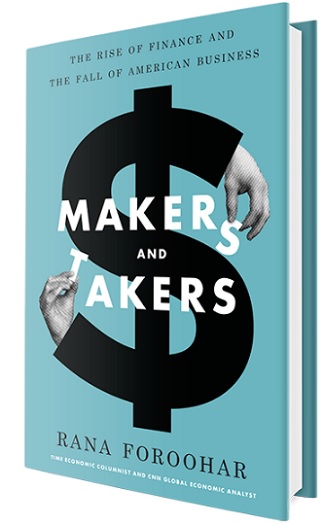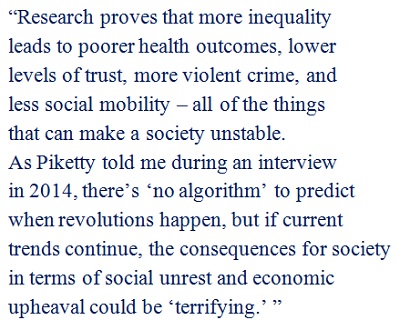By Pam Martens and Russ Martens: July 15, 2016
 Rana Foroohar has written the equivalent of a public guide to why Americans remain mad as hell at Wall Street and Washington and why a lot worse than a political revolution may ensue if the plutocrats don’t wake up soon. Foroohar is an assistant managing editor at Time magazine and its economics columnist. In “Makers and Takers: The Rise of Finance and the Fall of American Business,” the author lays out a number of undeniable truths, which she backs up with footnotes and facts, such as: “the business of America isn’t business anymore.” That’s given way to financial engineering tricks like loading up a company’s balance sheet with billions of dollars of debt in order to prop up the share price with buybacks of the company’s own stock.
Rana Foroohar has written the equivalent of a public guide to why Americans remain mad as hell at Wall Street and Washington and why a lot worse than a political revolution may ensue if the plutocrats don’t wake up soon. Foroohar is an assistant managing editor at Time magazine and its economics columnist. In “Makers and Takers: The Rise of Finance and the Fall of American Business,” the author lays out a number of undeniable truths, which she backs up with footnotes and facts, such as: “the business of America isn’t business anymore.” That’s given way to financial engineering tricks like loading up a company’s balance sheet with billions of dollars of debt in order to prop up the share price with buybacks of the company’s own stock.
Foroohar, who has been a financial journalist for 23 years, correctly concludes that Wall Street has come to “rule” rather than to “fuel” the real economy. This has created a “dysfunctional financial system” that is doomed to another collapse, “taking us all down with it,” unless critical repairs are made soon. Foroohar maps out exactly what those repairs must be in her last chapter.
The author gives a litany of examples to show how “finance has transitioned from an industry that encourages healthy risk-taking, to one that simply creates debt and spreads unproductive risk in the market system as a whole.”
One case study Foroohar examines is the technology company, Apple, and its use of share buybacks built on borrowed money. Unfortunately, Apple is part of a mushrooming trend in such financial engineering. Foroohar writes:
“…Apple’s behavior is no aberration. Stock buybacks and dividend payments of the kind being made by Apple – moves that enrich mainly a firm’s top management and its largest shareholders but often stifle its capacity for innovation, depress job creation, and erode its competitive position over the longer haul – have become commonplace. The S&P 500 companies as a whole have spent more than $6 trillion on such payments between 2005 and 2014, bolstering share prices and the markets even as they were cutting jobs and investment.”
The flip slide of this financial trickery (she calls it “financialization’) says Foroohar is that “our economy limps along in a ‘recovery’ that is tremendously bifurcated. Wage growth is flat. Six out of the top ten fastest-growing job categories pay $15 an hour and workforce participation is as low as it’s been since the late 1970s. It used to be that as the fortunes of American companies improved, the fortunes of the average American rose, too. But now something has broken that relationship.”
In a word, that “something” is insatiable Wall Street greed where the people’s savings deposits that President Bill Clinton allowed Wall Street to manage through the repeal of the Glass-Steagall Act are being used for speculative trading and financial engineering instead of loans to help businesses thrive. Foroohar explains:
“Lending to small business has fallen particularly sharply, as has the number of start-up firms themselves. In the early 1980s, new companies made up half of all US businesses. By 2011, they were just a third, a trend that numerous academics and even many investors and businesspeople have linked to the financial industry’s change in focus from lending to speculation. The wane in entrepreneurship means less economic vibrancy, given that new businesses are the nation’s foremost source of job creation and GDP growth.”
If the majority of Americans don’t catch on quickly to the fact that the Dodd-Frank financial reform legislation has failed to meaningfully correct America’s systemically dysfunctional financial system, the author worries that an ugly revolution may result. She writes:
“Research proves that more inequality leads to poorer health outcomes, lower levels of trust, more violent crime, and less social mobility – all of the things that can make a society unstable. As [Thomas] Piketty told me during an interview in 2014, there’s ‘no algorithm’ to predict when revolutions happen, but if current trends continue, the consequences for society in terms of social unrest and economic upheaval could be ‘terrifying.’ ”
Foroohar offers outstanding ideas for getting at the core of the problems. One notable idea is to create for finance what the National Transportation Safety Board became for the airlines – an independent examiner of crashes. Some Americans are not clamoring for change on Wall Street because the details of the corruption and dysfunction on Wall Street have been drowned out by a chorus of Wall Street’s sycophants peddling their own narrative and Republicans in Congress looking to score points with conservatives by promising to gut financial regulations.
Dodd-Frank created the Office of Financial Research (OFR), which has done outstanding work but is currently part of the U.S. Treasury Department which is headed by a political appointee made by whatever President and party is in office. Moving OFR out of the Treasury Department and making it function more like the National Transportation Safety Board is one of many fine examples offered by Foroohar to ward off the next, potentially seismic, crash of our financial system.
We highly recommend this book for summer reading as the dangerous stakes in the upcoming November election for choosing the President and members of Congress come in to ever sharper focus.


